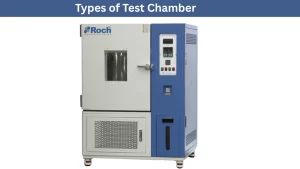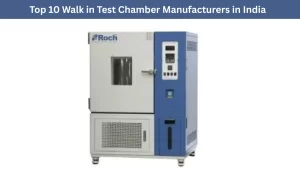What is a Walk in Test Chamber?
A walk in test chamber is a large, controlled environment designed to simulate specific temperature, humidity, and environmental conditions for testing the performance, durability, and reliability of products or materials over extended periods. These chambers are typically used to test items or products requiring significant space, such as large components, electronics, vehicles, or industrial machinery.
Key Features of Walk in Test Chamber
- Large Size: Unlike smaller lab chambers, walk-in test chambers provide enough space for large test samples or batches of products to be tested simultaneously.
- Temperature Control: They offer precise control over temperature conditions, from extremely low to high temperatures, to test how products react to temperature fluctuations.
- Humidity Control: These chambers can also regulate humidity, allowing for tests under various moisture conditions, from dry to highly humid environments.
- Programmability: Many walk-in chambers come with programmable controllers that set specific testing conditions, such as cyclical temperature and humidity profiles.
Uses of Walk in Test Chamber
- Environmental Stress Testing: Simulating real-world conditions to test product durability.
- Electronics Testing: Assessing the performance of devices under varying temperatures and humidity.
- Material Testing: Checking the resilience of materials like metals and plastics to extreme conditions.
Choosing the right walk in test chamber for your laboratory involves careful consideration of your specific testing requirements, budget, and technical specifications. Walk-in test chambers provide controlled environments for testing product durability, stability, and behavior under various environmental conditions, making them essential for many laboratories. Here’s a guide to help you make an informed choice:
1. Define Your Testing Requirements
- Temperature and Humidity Range: Identify the minimum and maximum temperatures and humidity levels required for your tests. Walk-in test chambers vary widely in their capabilities, so ensure the chamber can consistently reach and maintain your desired environmental conditions.
- Test Duration: Determine whether you need the chamber for short-term or extended testing periods, as this affects the type of cooling and heating systems required.
- Type of Tests: Different chambers are designed for specific tests such as thermal shock, stability testing, and humidity resistance. Understanding the nature of your tests will help you choose the right chamber model.
2. Consider the Size and Capacity
- Internal Volume: Choose a chamber size that accommodates the volume and dimensions of the items you plan to test. Avoid selecting a chamber that’s too large or small for your needs, as this can lead to inconsistent results.
- Laboratory Space: Evaluate the available space in your lab and confirm that it can accommodate the chamber. Remember to account for additional clearance for airflow and maintenance access.
3. Assess Temperature and Humidity Control Precision
- Uniformity and Stability: Look for a chamber with high temperature and humidity uniformity to ensure consistent results throughout the chamber. High-quality chambers have uniformity ratings to show how evenly conditions are maintained.
- Controller and Programmability: Some chambers feature advanced controllers that allow for pre-set programs and real-time adjustments. This feature is beneficial for labs that require precise, repeatable testing processes.
4. Select the Appropriate Cooling and Heating System
- Cooling Systems: For low-temperature testing, choose chambers with reliable refrigeration systems. Advanced chambers may offer cascade refrigeration for ultra-low temperatures.
- Heating Elements: If your tests require rapid heating, look for a chamber with powerful heating elements that can achieve high temperatures quickly.
- Dehumidification and Humidification Systems: These systems are essential for maintaining precise humidity levels. Consider chambers with steam injection or desiccant systems for high humidity control precision.
5. Energy Efficiency and Operational Costs
- Choose a chamber designed to be energy-efficient, as they are cost-effective in the long run. Efficient insulation, optimized compressors, and smart controllers can help reduce power consumption and operating costs.
6. Durability and Build Quality
- A well-built chamber with high-quality insulation, corrosion-resistant materials, and a robust outer frame will ensure longevity. Look for chambers made from stainless steel or powder-coated steel for durability.
7. Ease of Maintenance and Serviceability
- Maintenance Features: Choose a chamber that allows for easy access to key components for cleaning, filter changes, and other routine maintenance. Chambers with diagnostic tools or alerts for maintenance requirements are beneficial for avoiding downtime.
- Service and Warranty: Consider manufacturers who offer reliable service plans and warranties. This support is valuable for long-term performance and any future repairs or parts replacements.
8. Safety Features
- Look for built-in safety features, including overheat protection, circuit protection, and alarms for temperature/humidity deviations. Safety mechanisms protect both the chamber and its contents from damage during testing.
9. Budget and Cost Analysis
- Balance initial costs with long-term operational expenses, as high-quality chambers might have a higher upfront cost but lower maintenance and operational costs. Additionally, ensure you budget for any necessary accessories like racks or humidity probes.
10. Consult with Manufacturers and Suppliers
- Talk to manufacturers or suppliers to understand the specific features, benefits, and limitations of various models. They can provide insights into customization options and offer demonstrations if needed.
- Choosing the right walk-in test chamber is critical for accurate and reliable testing. By carefully evaluating these factors, you can select a chamber that aligns with your laboratory’s needs and provides consistent, controlled testing environments.
About Roch Mechatronics Inc.:
Roch Mechatronics Inc., located in Ghaziabad, Uttar Pradesh, is a leading manufacturer of Walk-in Chamber. Renowned for our exceptional quality and client satisfaction, we specialize in Test Chamber, Environmental Chamber, Humidity Chamber, and Battery Test Chamber. Our standout feature is our 24/7 customer support, ensuring you always have assistance when needed. For inquiries or support, call us at +91-7011654652 or email info@rochmechatronics.com, rochmechatronicsinc@gmail.com



